I made two resolutions for the year 2011: the first was to go backpacking in Glacier National Park and the second was to prepare foie gras au torchon. They kind of cancel each other out, don't they? Lose five pounds hiking in the wilderness and then gain them back gorging myself on fatty duck liver. Well, as you know, the former resolution worked out beautifully--a revelation, a mass of stone, a weeping glacier, and quite a workout. Quite possibly the best week and a half I've had in the past few years. So, as the days in December were dwindling away this year, I was really beginning to regret that I had never gotten around to procuring a slab of foie for myself. Not that I was five pounds lighter than I wanted to be at the end of December. Oh, heavens no. 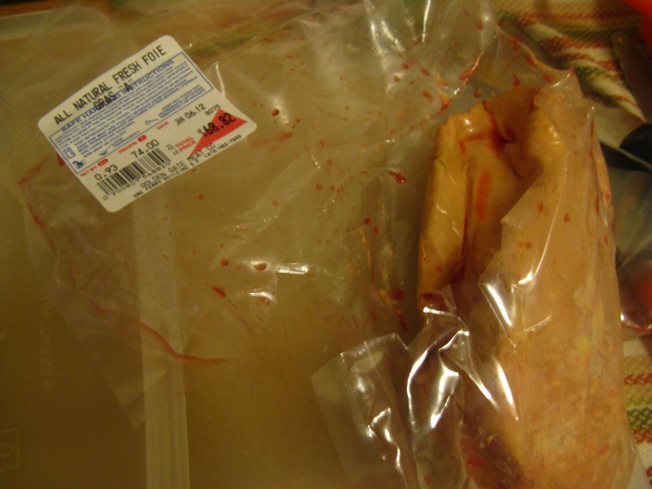 So I fudged a little bit--I decided that the aforementioned resolutions were meant to be completed by the conclusion of my twenty-fifth year on Earth, not the end of the year 2011. I also decided that a lobe of Grade A foie gras would be a perfect twenty-sixth birthday present to myself. See how well that works? And so, last Friday, only five days from the beginning of my late twenties, staring down a four-day foie gras recipe, I got on my bike and rode down to Golden Gate Meat, where I forked over a hefty sum for a laminated liver still oozing blood. How hefty of a sum? Let's just say I liked it better when my friend Chelsea asked, "How much does foie gras cost? Per ounce?" At least then the answer is a single-digit number of dollars.
So I fudged a little bit--I decided that the aforementioned resolutions were meant to be completed by the conclusion of my twenty-fifth year on Earth, not the end of the year 2011. I also decided that a lobe of Grade A foie gras would be a perfect twenty-sixth birthday present to myself. See how well that works? And so, last Friday, only five days from the beginning of my late twenties, staring down a four-day foie gras recipe, I got on my bike and rode down to Golden Gate Meat, where I forked over a hefty sum for a laminated liver still oozing blood. How hefty of a sum? Let's just say I liked it better when my friend Chelsea asked, "How much does foie gras cost? Per ounce?" At least then the answer is a single-digit number of dollars.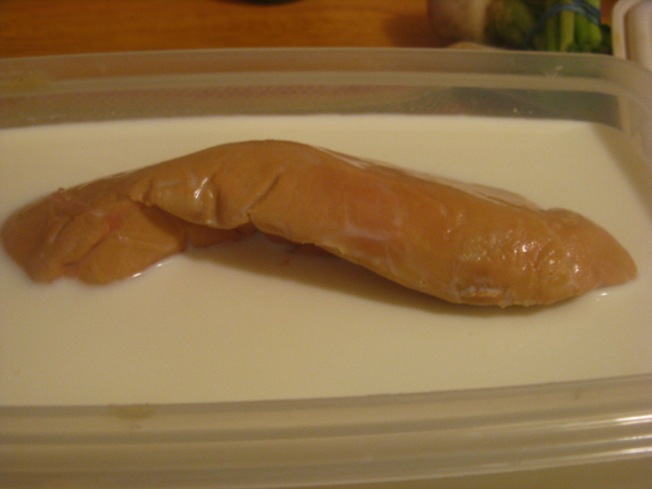 It seems that the first step in preparing foie gras is to soak it in a vat of milk overnight to draw out as much blood as possible. As luck would have it, we had a half-gallon of milk hanging out in our fridge from a few stalled attempts at making eggnog. So, really, in buying this foie gras, I was saving money, because I was finding a use for some perfectly good milk that I otherwise would have dumped down the drain. In twenty-one years of schooling, I have never actually taken an economics class.
It seems that the first step in preparing foie gras is to soak it in a vat of milk overnight to draw out as much blood as possible. As luck would have it, we had a half-gallon of milk hanging out in our fridge from a few stalled attempts at making eggnog. So, really, in buying this foie gras, I was saving money, because I was finding a use for some perfectly good milk that I otherwise would have dumped down the drain. In twenty-one years of schooling, I have never actually taken an economics class.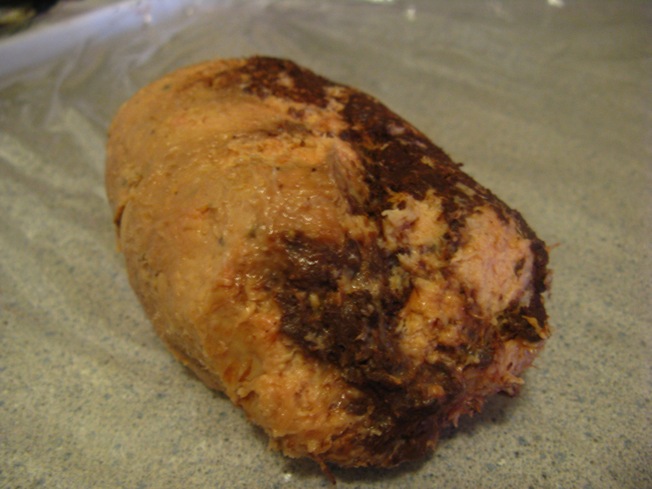 The recipe I used, from the Eleven Madison Park cookbook, then calls for you to de-vein the foie (imagine playing with moist bloody Play-Doh for 90 minutes), marinate it in a mixture of curing salt and sugar overnight, then slice it up again, layer it with artisan cocoa and coriander, and roll it between triple-thick plastic wrap into a perfect livery log that you freeze overnight. That's a lot of things, and we're only halfway there. This recipe was a real milestone for me. I don't think I have ever spent this much time or money on a single dish before. Nor have I ever prepared anything that looked so much like poop.
The recipe I used, from the Eleven Madison Park cookbook, then calls for you to de-vein the foie (imagine playing with moist bloody Play-Doh for 90 minutes), marinate it in a mixture of curing salt and sugar overnight, then slice it up again, layer it with artisan cocoa and coriander, and roll it between triple-thick plastic wrap into a perfect livery log that you freeze overnight. That's a lot of things, and we're only halfway there. This recipe was a real milestone for me. I don't think I have ever spent this much time or money on a single dish before. Nor have I ever prepared anything that looked so much like poop.
 It's funny, though: when I first bought the Eleven Madison Park cookbook I almost immediately resigned myself to the idea that it would be relegated to the coffee table as a conversation piece, rather than used for its actual recipes. Those recipes--which call for half-cups of black truffles, 184 baby chervil leaves, 32 sprigs of flowering dill, six quarts of lobster stock, twenty minutes in a combination steam oven, seven days of dry-aging, 30 hours in a vacuum bag--just seemed so inaccessible, perhaps impossible, even in my well-stocked home kitchen.Then again, I remember having the same impression of Ad Hoc At Home. Who would take the time to blanch five different types of vegetables separately and prepare double-strength mushroom broth just to make a simple soup? Two years later... that's usually how I make soup nowadays. Not for dinner on a Tuesday night when I'm hungry and want some soup on the table in thirty minutes, but if I'm having some friends over for dinner, it makes my life a lot easier and produces a better result--vegetables perfectly crisp, potatoes full of flavor, a rich and sweet stock that cloaks your tongue with each sip.
It's funny, though: when I first bought the Eleven Madison Park cookbook I almost immediately resigned myself to the idea that it would be relegated to the coffee table as a conversation piece, rather than used for its actual recipes. Those recipes--which call for half-cups of black truffles, 184 baby chervil leaves, 32 sprigs of flowering dill, six quarts of lobster stock, twenty minutes in a combination steam oven, seven days of dry-aging, 30 hours in a vacuum bag--just seemed so inaccessible, perhaps impossible, even in my well-stocked home kitchen.Then again, I remember having the same impression of Ad Hoc At Home. Who would take the time to blanch five different types of vegetables separately and prepare double-strength mushroom broth just to make a simple soup? Two years later... that's usually how I make soup nowadays. Not for dinner on a Tuesday night when I'm hungry and want some soup on the table in thirty minutes, but if I'm having some friends over for dinner, it makes my life a lot easier and produces a better result--vegetables perfectly crisp, potatoes full of flavor, a rich and sweet stock that cloaks your tongue with each sip.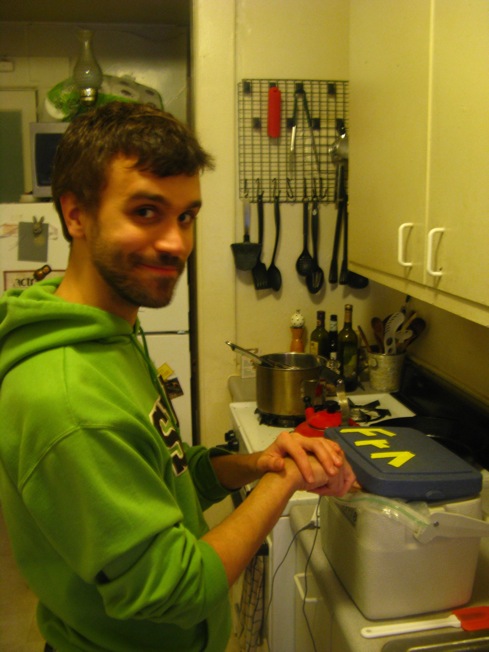 Rolling foie gras up with sifted cocoa is not a new skill that I anticipate using in the near future. It seems a little esoteric. Who knows? Never say never. But I might be tempted to try my hand at sous vide cooking again. The Eleven Madison Park recipe called for me to poach my frozen torchon for six to seven minutes in a water bath maintained at exactly 137 degrees Fahrenheit. Using Kenji's method and a surprisingly well-insulated beer cooler I found on the street a few years ago, along with Jeff's kitchen thermometer and a sturdy spoon to keep the log submerged, I indeed kept that foie nice and lukewarm for seven minutes, with nary a degree in temperature variation. And they tell me I could do the same thing with a medium rare steak the next time I have people over, taking it out of the bag for just a quick sear before serving? Oh, this is getting exciting.
Rolling foie gras up with sifted cocoa is not a new skill that I anticipate using in the near future. It seems a little esoteric. Who knows? Never say never. But I might be tempted to try my hand at sous vide cooking again. The Eleven Madison Park recipe called for me to poach my frozen torchon for six to seven minutes in a water bath maintained at exactly 137 degrees Fahrenheit. Using Kenji's method and a surprisingly well-insulated beer cooler I found on the street a few years ago, along with Jeff's kitchen thermometer and a sturdy spoon to keep the log submerged, I indeed kept that foie nice and lukewarm for seven minutes, with nary a degree in temperature variation. And they tell me I could do the same thing with a medium rare steak the next time I have people over, taking it out of the bag for just a quick sear before serving? Oh, this is getting exciting.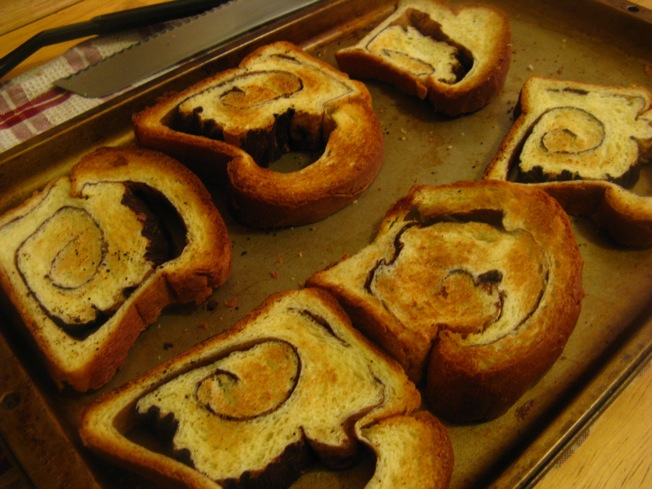 So, yes, I successfully soaked and deveined and torchoned and sousvided a foie gras this weekend. What else did I learn how to do? I made quince stock in a double boiler. It took four hours. That's like eight hours of single boiling. I then reduced this stock into a savory quince sauce and a sweet quince gelee. (Sorry if some elements of this recipe are getting a little obscure. If you don't know what a gelee is, just imagine quince JELL-O. If you don't know what a quince is, imagine a pear and then imagine paying five times more for it.) Oh, and I made brioche, also spiked with a sweet vein of cocoa. I used my KitchenAid. I didn't hurt myself this time. Sam's Mom would be proud.
So, yes, I successfully soaked and deveined and torchoned and sousvided a foie gras this weekend. What else did I learn how to do? I made quince stock in a double boiler. It took four hours. That's like eight hours of single boiling. I then reduced this stock into a savory quince sauce and a sweet quince gelee. (Sorry if some elements of this recipe are getting a little obscure. If you don't know what a gelee is, just imagine quince JELL-O. If you don't know what a quince is, imagine a pear and then imagine paying five times more for it.) Oh, and I made brioche, also spiked with a sweet vein of cocoa. I used my KitchenAid. I didn't hurt myself this time. Sam's Mom would be proud.
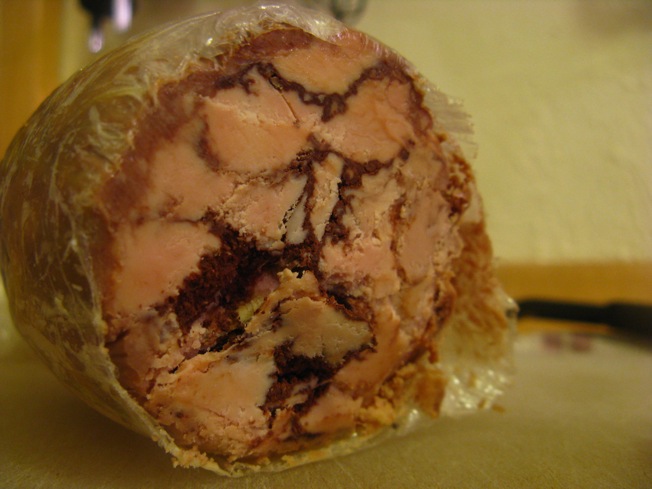 I really wanted to make sure that I got everything exactly right before inviting over a few foie-loving foiends for dinner on Monday. Nothing would be more embarrassing than hosting a pre-birthday dinner and slicing into that thick torchon of the star ingredient only to find it dissolving into a puddle of gristly liver and raw cocoa. Well, unless my fly was down at the same time. Thankfully, everything seemed to work out just fine--the foie tightly rolled and free of air bubbles, the gelee set, the sauce smooth, the brioche curled into a soft spiral. Oh, and just imagine my delight when I sliced into that torchon and found it so beautifully impregnated with rich chocolaty goodness. Not quite as beautifully impregnated as the torchon on page 256 of the Eleven Madison Park cookbook, or as Demi Moore on the cover of Rolling Stone, but not bad for a first try.
I really wanted to make sure that I got everything exactly right before inviting over a few foie-loving foiends for dinner on Monday. Nothing would be more embarrassing than hosting a pre-birthday dinner and slicing into that thick torchon of the star ingredient only to find it dissolving into a puddle of gristly liver and raw cocoa. Well, unless my fly was down at the same time. Thankfully, everything seemed to work out just fine--the foie tightly rolled and free of air bubbles, the gelee set, the sauce smooth, the brioche curled into a soft spiral. Oh, and just imagine my delight when I sliced into that torchon and found it so beautifully impregnated with rich chocolaty goodness. Not quite as beautifully impregnated as the torchon on page 256 of the Eleven Madison Park cookbook, or as Demi Moore on the cover of Rolling Stone, but not bad for a first try.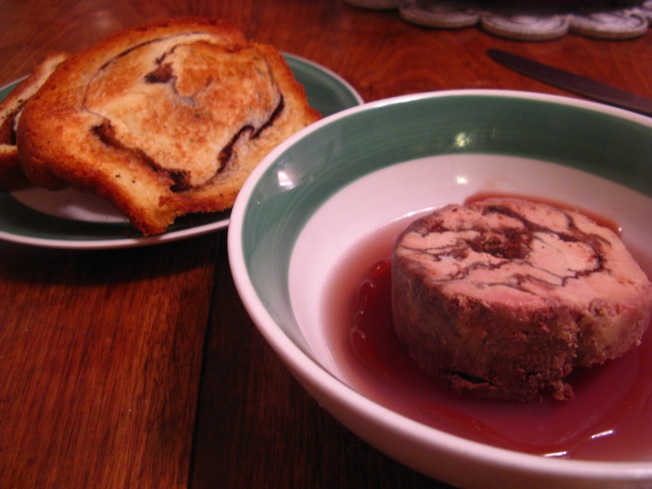 Was it the best thing I have ever made? Well, no. I found all of the flavors, taken together, to be strangely muted--kind of a bummer, because I used good-quality ingredients for every element of the dish, so it was a surprise that nothing really sang. I think I liked the ten-dollar, totally vegan pot of bean soup that Jeff prepared as a main course even better. But in the end, was it really about the taste? Or was it about the process? Learning a half-dozen new techniques, working with a new ingredient, dedicating myself to a craft for a few days, taking a staycation in my own apartment for a few hours a day, sharing it with an ad hoc group of friends snapping away around the dining room table? If my trip to Glacier was about the beauty of the natural world, was my trip into foie gras about the beauty of the manufactured world?Anyway, it was a good way to start year twenty-six.--Recipe roundup...Foie gras torchon with quince and cocoa recipe from the Eleven Madison Park: The Cookbook.I also incorporated some suggestions from Thomas Keller's French Laundry cookbook, particularly the initial soak in milk and the deveining process. Carol Blymire chronicled the preparation of that dish here. She is a trooper. A stormtrooper.I didn't have any sheets of gelatin for the quince gelee, but I did have Knox powdered gelatine. Seeing that their suggested ratio for free-standing jelly blocks was one envelope of gelatin per cup of liquid, and knowing that I wanted my gelee to be a little less firm, I used one envelope of gelatin for two cups of quince stock. I probably could have gotten away with even a little less, but the texture wasn't too bad.Eleven Madison Park's instructions for making brioche did not work for me at all. Maybe I just don't know how to make brioche, but the dough somehow managed to morph into pasta dough, buttercream frosting, and pie crust, without ever actually resembling, you know, bread dough. So I used this hand-holdy KitchenAid recipe from Rose Levy Berenbaum, with the same butter:flour ratio suggested by the EMP recipe. It worked pretty well, and I'm glad I have another loaf hanging out in the freezer.
Was it the best thing I have ever made? Well, no. I found all of the flavors, taken together, to be strangely muted--kind of a bummer, because I used good-quality ingredients for every element of the dish, so it was a surprise that nothing really sang. I think I liked the ten-dollar, totally vegan pot of bean soup that Jeff prepared as a main course even better. But in the end, was it really about the taste? Or was it about the process? Learning a half-dozen new techniques, working with a new ingredient, dedicating myself to a craft for a few days, taking a staycation in my own apartment for a few hours a day, sharing it with an ad hoc group of friends snapping away around the dining room table? If my trip to Glacier was about the beauty of the natural world, was my trip into foie gras about the beauty of the manufactured world?Anyway, it was a good way to start year twenty-six.--Recipe roundup...Foie gras torchon with quince and cocoa recipe from the Eleven Madison Park: The Cookbook.I also incorporated some suggestions from Thomas Keller's French Laundry cookbook, particularly the initial soak in milk and the deveining process. Carol Blymire chronicled the preparation of that dish here. She is a trooper. A stormtrooper.I didn't have any sheets of gelatin for the quince gelee, but I did have Knox powdered gelatine. Seeing that their suggested ratio for free-standing jelly blocks was one envelope of gelatin per cup of liquid, and knowing that I wanted my gelee to be a little less firm, I used one envelope of gelatin for two cups of quince stock. I probably could have gotten away with even a little less, but the texture wasn't too bad.Eleven Madison Park's instructions for making brioche did not work for me at all. Maybe I just don't know how to make brioche, but the dough somehow managed to morph into pasta dough, buttercream frosting, and pie crust, without ever actually resembling, you know, bread dough. So I used this hand-holdy KitchenAid recipe from Rose Levy Berenbaum, with the same butter:flour ratio suggested by the EMP recipe. It worked pretty well, and I'm glad I have another loaf hanging out in the freezer.
The bean soup was of course this old standby. It was my birthday!

I cannot believe you made this! Kudos to your motivation...anytime I see a recipe that calls for 4 hours of anything, unless it's a roast chicken, I just walk away and don't look back. Let's make a deal...if we're ever in the same city/state on our bdays, I will bake you whatever you want if you make me duck confit and foie gras. That is obviously a fair trade....
ReplyDelete